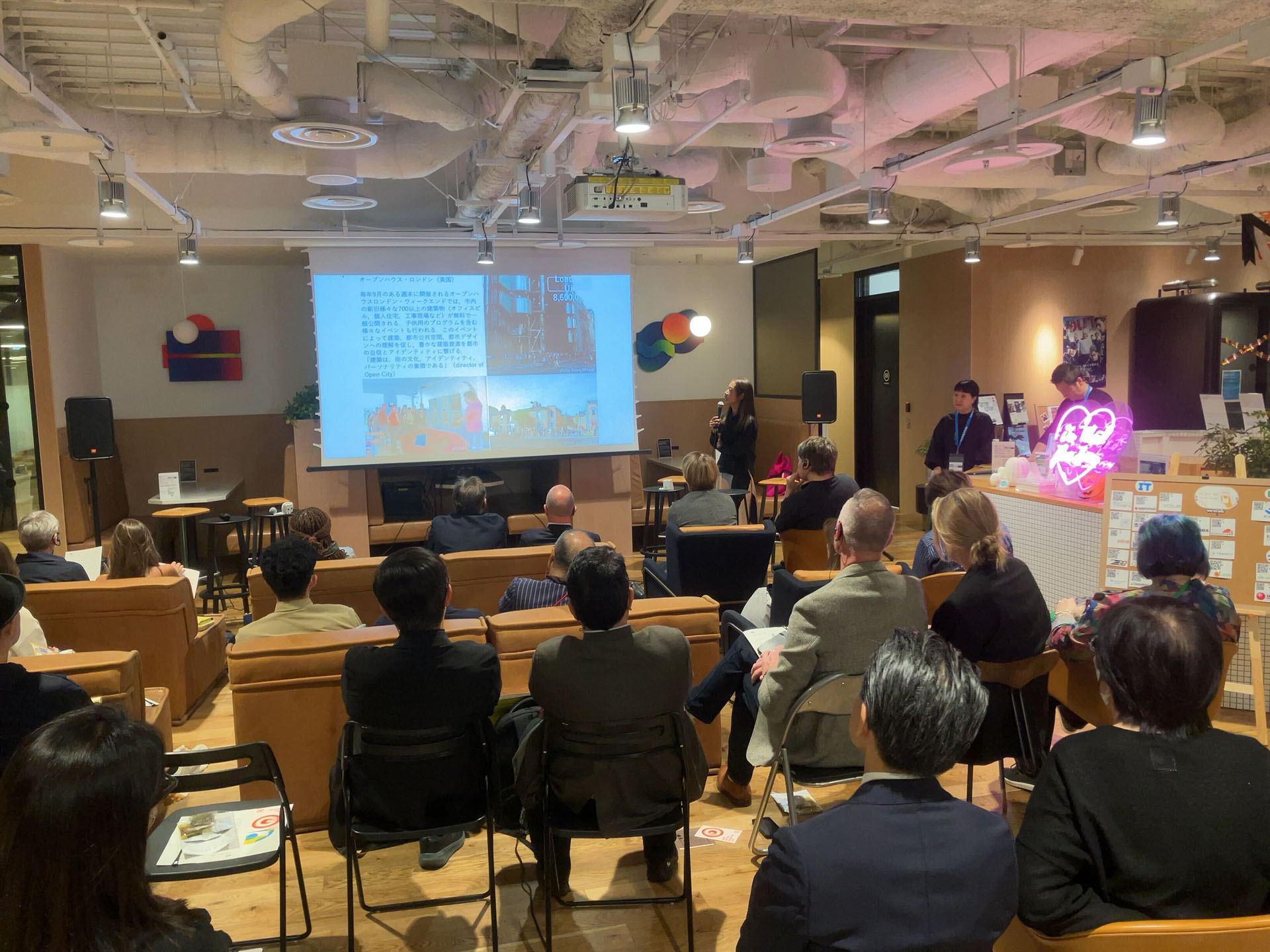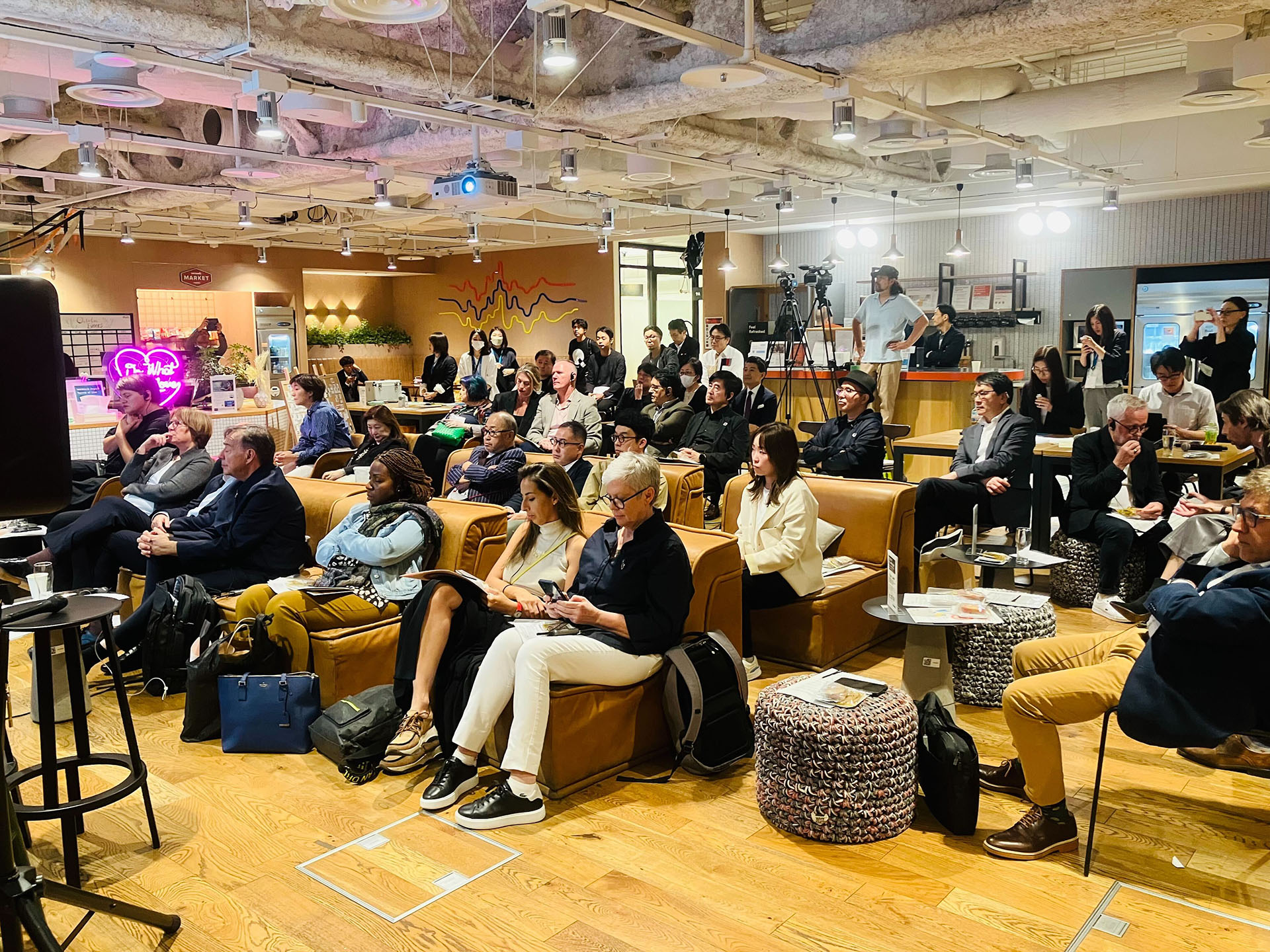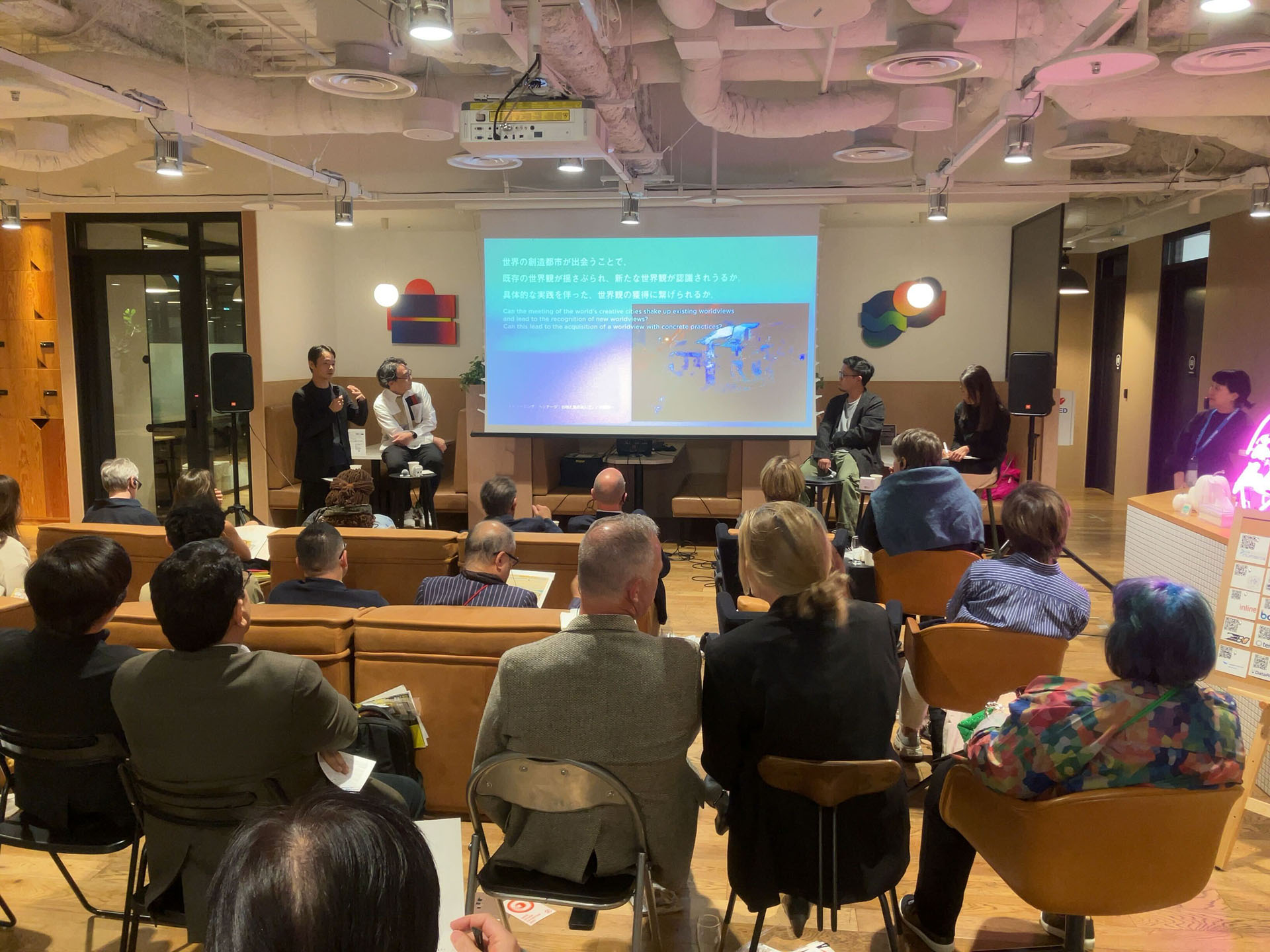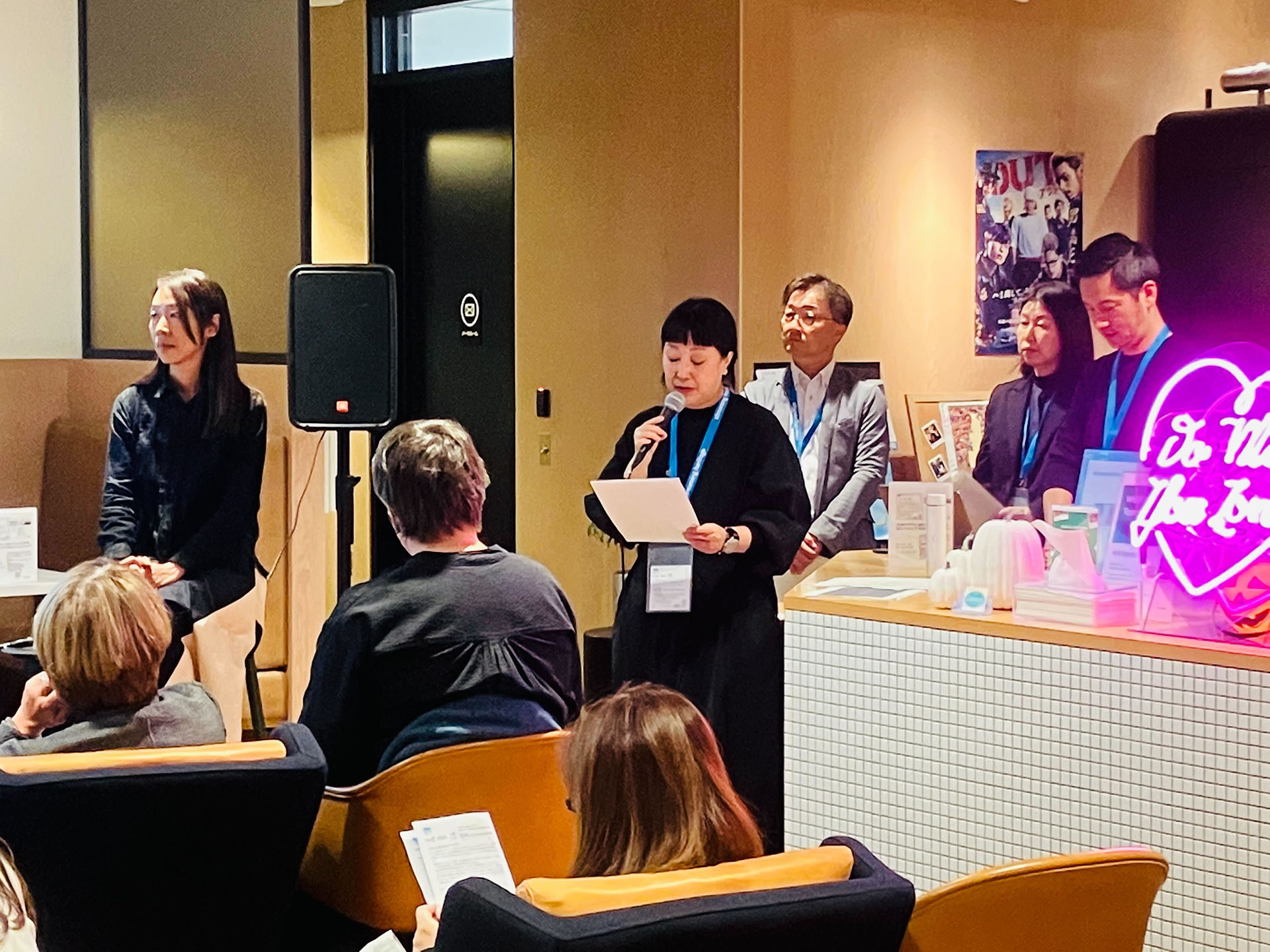Report
Asahikawa, Kobe, and Nagoya, all designated UNESCO Creative Cities Network (UCCN) Design Cities, collaborated in organizing a conference held as the WDO World Design Assembly Tokyo 2023 Authorized Program.
The first section of the conference featured the keynote speech, a lecture on the theme of Civic Pride. In the second section, a “cross talk” panel discussion with guest experts who focus on design from a variety of perspectives provided participants an opportunity to learn about the network of Design Cities and deepen their understanding of the possibilities of intercity collaborations.
Part 1
Keynote Speech
Dr. Kaori Ito “Urban Creativity and Civic Pride”
Dr. Kaori Ito described how her research on 472 cities she has conducted thus far indicates that aside from recent globalization, cities have also historically had mutual relations and learned from each other at various levels, and explained the origins of inter-city networks.
She went on to describe how civic pride is core to the relationship between cities and people as the culture, civilization, and creativity are fostered by the exchange of information and mutual stimulation that occurs when people are concentrated in cities.
A philosophy rather resembling “self-governance,” civic pride is also referenced in “Civic Pride—Designing the Communication of the City,” emphasizing the importance of designing contact points that get citizens involved in actions and of spurring communication that fosters civic pride. Specific examples of programs fostering civic pride include “Open House London” (UK), held for two days every year and taking the perspective of “knowing your city,” enabling participants to learn about the city through London’s distinguished history and innovative architecture. Another example is a case study of Aarhus (Denmark), European Capital of Culture in 2017, based on the perspective of “self-actualization in the city.” Through the independent activities of “re-thinkers,” a volunteer organization that guides tourists and visitors from outside the city and organizes events, and described Ito introduced program design that leverages the three elements of identity, community, and motivation.
Then, taking the viewpoint of “embodying the culture of the city,” she introduced with numerous photographs a “Landscape Formation Project (city stream project),” which began in Mishima City, Shizuoka Prefecture with a citizen-led initiative and was implemented with citizens, companies, town development groups, and the government working in collaboration, with each taking on a respective role.
Ito concluded the lecture by mentioning the importance of everyone sharing the relationship between “city” and “self,” that is, communicating by seeing, touching, and experiencing things together, along with the fact it is the citizens (ourselves) who embody the city, now as well as in the future.


Part 2
Cross Talk
Mr. Hiroki Tokuyama discussed the potential of “Citizen-Centered Design,” a design process in which diverse citizens are conscious of their responsibilities as individual members of the society to which they belong. They engage in highly creative and inventive activities, collaborating with governments and experts to solve problems.
He used the example of citizens working together in the construction of public buildings in Tohoku after the Great East Japan Earthquake. Four commercial facilities in the Naiwan (Inner Bay) area, Mukaeru (Welcome), Yuwaeru (Connect), Hirakeru (Open), and Umareru (Creation), were opened as part of the seawall project in the bay area of Kesennuma City, Miyagi Prefecture, giving rise to a forum for various experts, citizen groups, government agencies, and citizens to exchange views.
In establishing a symbolic open space in front of the train station in Onagawa Town, Miyagi Prefecture, experts facilitated discussions between one hundred citizens and the town mayor, with the planning and decision-making conducted openly.
In Sukagawa City, Fukushima Prefecture, in establishing a community center that included a library, a series of workshops was held which 700 citizens participated. There was also a joint public-private examination of advanced cases, and the center has continued to be operated with citizen participation even after opening.
Tokuyama explained that modern society’s top-down system of manufacturing has reached its limits, and he emphasized the importance of transitioning from the concept of fitting in conventional boxes to spontaneous creation of commons (shared assets) required by the residents.
Dr. Tomohide Mizuuchi then spoke on the subject of how creative cities can design alternative worldviews. He introduced the topic of acquiring “futures literacy,” that is, the ability to imagine the future that UNESCO started exploring and developing in 2012, through which we can enhance our powers of imagination, resilience in the face of change, and ability to invent.
Using various examples, Mizuuchi explained that in dealing with today’s complex issues, it is important to redefine the basic core—what design is—and to recognize that there are various approaches and methods for developing designs to shift systems.
Lastly, he posed the question of whether the origins of building a sustainable world and creating a worldview that diverges from the current trajectory might be found in Creative Cities, and whether the network of creative cities around the world following certain concrete practices would lead to the acquisition of a new worldview.
Mr. Shinji Yajima introduced the following examples that focus on civic pride among Good Design Award-winning works, primarily those from 2023.
“Kamiyama Marugoto Kosen” Kamiyama Town, Tokushima Prefecture: The establishment of “Kamiyama Marugoto Kosen” (Kamiyama Marugoto College of Design, Engineering and Entrepreneurship) was implemented as a new initiative with the theme of “creative depopulation” in Kamiyama Town, Tokushima Prefecture, where a local NPO has been active for over twenty years. This fully residential technical college itself serves as an information center. By bringing students together, it has become a form of infrastructure that fosters new leaders in the city and produces human resources capable of working anywhere in Japan. Another highly respected aspect was its superior performance in disseminating information, a practice cultivated through cultural projects and creator migration policies in place since before the opening of the technical college.
“Haga-Utsunomiya LRT” in Utsunomiya City, Tochigi Prefecture: This is a superb example of creating opportunities for citizens to become more engaged. In this case, design includes not only the railway but also signs, cleverly creating visual expression that changes the townscape and leads to greater civic pride.
ES- CON FIELD HOKKAIDO in Kitahiroshima City, Hokkaido: Located immediately adjacent to Sapporo, these cities welcome and actively participate in community development, with their baseball stadium serving as a focal point of pride. Increasing numbers of people from all over the world come to visit this baseball stadium as a tourist destination, even on non-game days. As a result, the city pulls in over 3 million visitors, has seen construction of a new JR station, succeeded in attracting a university, and is expected to grow yet further.
“Higashi Yuenchi”, Kobe City, Hyogo Prefecture: In renovating the historic Higashi Yuenchi (Kobe East Park), workshops and various events, including social experiments were held., This created an opportune moment for the establishment of a new park. Through communication with local stakeholders, the practice of placemaking created a comfortable space and a new site in the city that would be a part of the residents’ daily lives.
“RENEW” in Sabae City, Echizen City, and Echizen Town, Fukui Prefecture: This initiative positions design as tourism. Through various events, the local people share in the role of producing new creations. This successful example of new city development is the culmination of ten years of involving citizens, local craftsmen, and businesses in creating a tourism resource.
A cross talk panel discussion with Dr. Kaori Ito followed.
Mr. Tokuyama was asked about how citizens can be involved during normal times, in contrast to the citizen-led design that developed in the wake of earthquake recovery. He responded that the type of “selfish” design requests and demands that arise from the actual experience of daily life become opportunities to involve citizens.
Dr. Mizuuchi was asked about the balance required to foster cities’ individuality in the face of their homogenization through networking. He replied that interaction between different cities has produced many appealing examples. He said cities’ incorporating and transmitting their own traditions, culture, and worldviews while simultaneously transmitting them produces a hybrid that leads to new creation.
Mr. Yajima was asked by Dr. Ito about the recent trend in which citizens as users are involved in design as proposers. Yajima replied that the key point is in a “semi-public” approach lying the between public and private spheres. He thinks that increased levels of citizenship will become even more important for Japan in the future, and that designers and creators should be involved in this, as it will clarify their new role in society.
Using this question as a starting point, the speakers discussed the role that designers play in civic pride, the relationship and interaction between government and citizens in design, and ways to foster cities’ uniqueness. Regarding the creative city network, as it is thought that exchanges between countries alone are not all that effective, the basic diplomatic stance will be to engage in more “compact” and nimble exchanges, such as those between cities. In addition, the opinion was expressed that a creative city framework featuring closer interactions and direct relationships continues to hold potential and should be utilized more in Japan.
In conclusion, Ms. Eriko Esaka from Nagoya, representing the organizers, spoke about the importance of considering design’s proper role for residents, mentioning that the expansion of the intercity network (anticipating further increases in Design City membership) will serve as an opportunity for governments and citizens to reconsider their perspectives on design.


Lastly, Dr. David Kusuma, the WDO President from 2022 to 2023, briefly introduced WDO’s urban projects. At a time when nations’ international competitiveness is being questioned, he expressed his hopes of “design for a better world” through cross-border programs and collaborations between city governments, in the private sector, and at the grass-root level.
The discussions and insightful perspectives developed during the crosstalk not only highlighted the possibilities and prospects for Design Cities, but also served as an opportunity to spur activity aimed at fostering civic pride.
With this conference, Asahikawa, Kobe, and Nagoya are again entrusted with further spreading the word that the point of being certified as a Design City and living in a Design City is not civic pride, but rather that all can share and practice design as citizens who embody their city.
To this end, the UNESCO Cities of Design Conference, Japan will assume the role of platform for exchanges and collaboration between Design Cities in Japan as we continue to actively collaborate in stimulating the citizens’ creative activities.